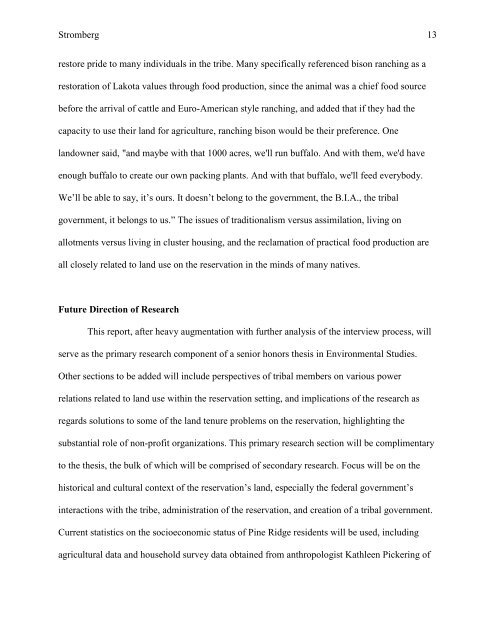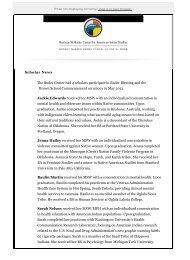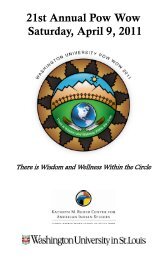Land Tenure and Livelihoods of the Oglala Lakota - Kathryn M ...
Land Tenure and Livelihoods of the Oglala Lakota - Kathryn M ...
Land Tenure and Livelihoods of the Oglala Lakota - Kathryn M ...
Create successful ePaper yourself
Turn your PDF publications into a flip-book with our unique Google optimized e-Paper software.
Stromberg 13<br />
restore pride to many individuals in <strong>the</strong> tribe. Many specifically referenced bison ranching as a<br />
restoration <strong>of</strong> <strong>Lakota</strong> values through food production, since <strong>the</strong> animal was a chief food source<br />
before <strong>the</strong> arrival <strong>of</strong> cattle <strong>and</strong> Euro-American style ranching, <strong>and</strong> added that if <strong>the</strong>y had <strong>the</strong><br />
capacity to use <strong>the</strong>ir l<strong>and</strong> for agriculture, ranching bison would be <strong>the</strong>ir preference. One<br />
l<strong>and</strong>owner said, "<strong>and</strong> maybe with that 1000 acres, we'll run buffalo. And with <strong>the</strong>m, we'd have<br />
enough buffalo to create our own packing plants. And with that buffalo, we'll feed everybody.<br />
We‟ll be able to say, it‟s ours. It doesn‟t belong to <strong>the</strong> government, <strong>the</strong> B.I.A., <strong>the</strong> tribal<br />
government, it belongs to us.” The issues <strong>of</strong> traditionalism versus assimilation, living on<br />
allotments versus living in cluster housing, <strong>and</strong> <strong>the</strong> reclamation <strong>of</strong> practical food production are<br />
all closely related to l<strong>and</strong> use on <strong>the</strong> reservation in <strong>the</strong> minds <strong>of</strong> many natives.<br />
Future Direction <strong>of</strong> Research<br />
This report, after heavy augmentation with fur<strong>the</strong>r analysis <strong>of</strong> <strong>the</strong> interview process, will<br />
serve as <strong>the</strong> primary research component <strong>of</strong> a senior honors <strong>the</strong>sis in Environmental Studies.<br />
O<strong>the</strong>r sections to be added will include perspectives <strong>of</strong> tribal members on various power<br />
relations related to l<strong>and</strong> use within <strong>the</strong> reservation setting, <strong>and</strong> implications <strong>of</strong> <strong>the</strong> research as<br />
regards solutions to some <strong>of</strong> <strong>the</strong> l<strong>and</strong> tenure problems on <strong>the</strong> reservation, highlighting <strong>the</strong><br />
substantial role <strong>of</strong> non-pr<strong>of</strong>it organizations. This primary research section will be complimentary<br />
to <strong>the</strong> <strong>the</strong>sis, <strong>the</strong> bulk <strong>of</strong> which will be comprised <strong>of</strong> secondary research. Focus will be on <strong>the</strong><br />
historical <strong>and</strong> cultural context <strong>of</strong> <strong>the</strong> reservation‟s l<strong>and</strong>, especially <strong>the</strong> federal government‟s<br />
interactions with <strong>the</strong> tribe, administration <strong>of</strong> <strong>the</strong> reservation, <strong>and</strong> creation <strong>of</strong> a tribal government.<br />
Current statistics on <strong>the</strong> socioeconomic status <strong>of</strong> Pine Ridge residents will be used, including<br />
agricultural data <strong>and</strong> household survey data obtained from anthropologist Kathleen Pickering <strong>of</strong>





